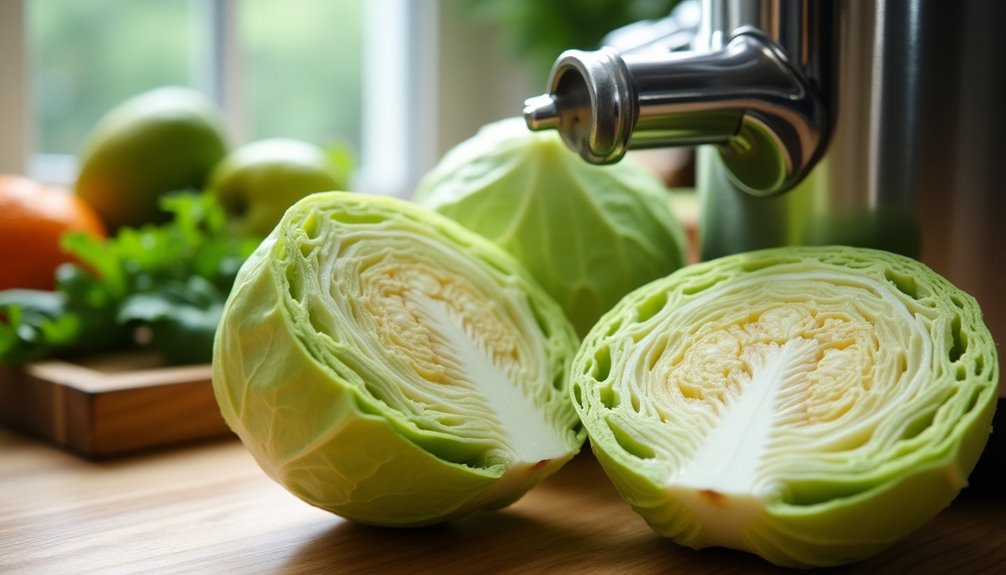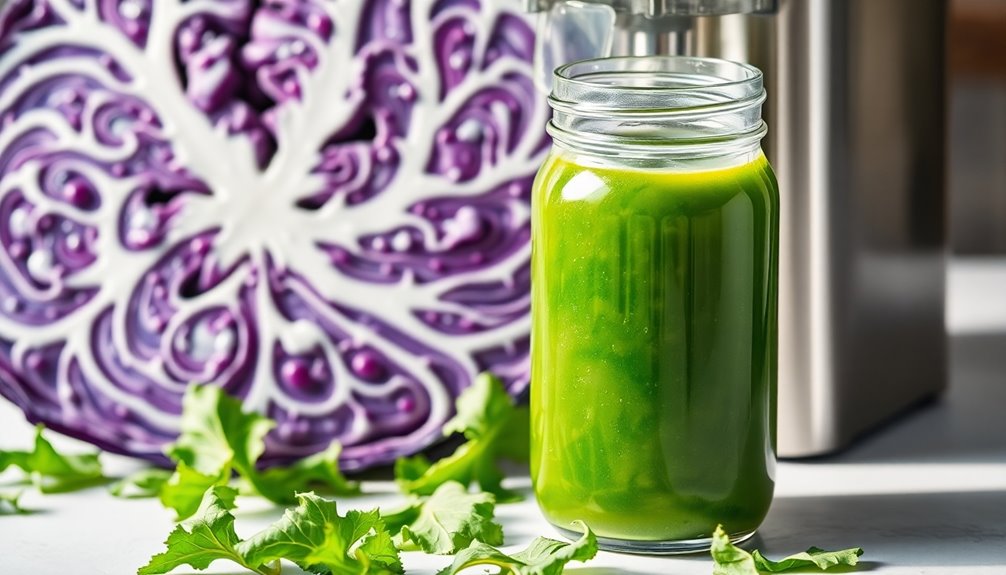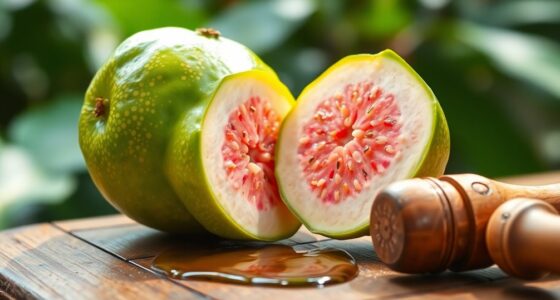To juice cabbage, start by rinsing a fresh head thoroughly and chopping it into 1-inch pieces. Blend the cabbage with some celery, carrots, and apples for added flavor and nutrition, then add filtered water. Strain the mixture through a sieve or use a juicer for quicker results. Enjoy your juice immediately for maximum benefits, but you can store it in an airtight container in the fridge for up to three days. There's more useful info ahead!
Key Takeaways
- Rinse a fresh head of cabbage thoroughly to remove any dirt or contaminants before juicing.
- Chop the cabbage into 1-inch pieces for easier blending and extraction of juice.
- Blend the cabbage with celery, carrots, apples, and filtered water for enhanced flavor and nutrition.
- Strain the blended mixture using a mesh bag or sieve, or use a juicer for quicker extraction.
- Consume the juice immediately for maximum health benefits, or store it in an airtight container in the refrigerator for up to 3 days.

Juicing cabbage is a simple and nutritious way to boost your health, and with just a few easy steps, you can enjoy its many benefits. Cabbage juice is packed with essential nutrients like vitamin C, which can help strengthen your immune system and assist digestion. You can easily incorporate this green powerhouse into your diet with a variety of cabbage juice recipes.
To get started, gather your ingredients. Take a fresh head of cabbage, rinse it thoroughly, and chop it into 1-inch pieces. If you want to enhance the flavor and nutrition of your juice, consider adding other ingredients like celery, carrots, or even apples. These additions not only improve taste but also provide extra health benefits.
Once you've prepped your ingredients, you're ready to begin juicing. If you're using a blender, add your chopped cabbage and any additional ingredients into the container. Pour in a small amount of filtered water to help facilitate blending. This step is crucial, as it gives your blender the necessary lubrication to operate efficiently, especially at high speed. Blend the mixture until it reaches a smooth consistency. You'll want to make sure that everything is well combined to extract the maximum nutrients from the cabbage.
Once you've blended your mixture, it's time to strain it. Pour the blended cabbage juice through a mesh bag or sieve to separate the pulp from the juice. This step ensures you get a smooth drink, making it easier to enjoy. If you prefer, you can use a juicer, which extracts juice directly from the vegetables, saving you some time. Either way, the end result is a refreshing and nutritious cabbage juice.
Fresh cabbage juice is best consumed immediately to reap its maximum health benefits. However, if you can't drink it right away, you can store it in an air-tight container in the fridge for up to 3 days. Just keep in mind that freshness is key to preserving the nutrients.
If you're looking for specific health improvements, like ulcer healing, drinking 8 oz. of cabbage juice 1-4 times daily is highly recommended. Studies suggest that this practice can help heal ulcers in approximately 9 days. Cabbage juice's natural properties, particularly when it undergoes fermentation, produce beneficial compounds that promote gut health and overall wellness.
Incorporating cabbage juice into your diet is a rewarding choice. With its numerous health benefits, from boosting your immune system to aiding digestion, it's a delicious way to nourish your body. So grab your cabbage, get your blender ready, and start enjoying the incredible advantages of this vibrant vegetable today!
Frequently Asked Questions
Can You Juice Cabbage Raw?
Yes, you can juice cabbage raw, and it's a great way to enjoy its nutrients.
When you choose fresh, firm heads without brown spots, you're ensuring the best quality juice.
Raw cabbage juice is packed with vitamins K, C, and U, which can help heal your stomach lining and reduce inflammation.
You should drink it right away for maximum benefits, but it'll stay fresh in the fridge for 3-4 days in an airtight container.
How to Make Juice of Cabbage?
To make juice, you'll want to start by rinsing and chopping your ingredients into small pieces.
If you've got cabbage, mix it with some celery or carrots for extra flavor.
Blend everything for a minute or two, adding a splash of water if needed.
Once it's smooth, strain the mixture to separate the juice from the pulp.
Enjoy your fresh juice right away for the best taste and nutrients!
How to Juice Cabbage Without a Juicer?
To juice cabbage without a juicer, start by washing and chopping the cabbage into 1-inch pieces.
Use a high-speed blender, adding a bit of filtered water to help blend smoothly. Blend for 1-2 minutes, then strain the mixture through a fine mesh sieve or nut milk bag.
Press down with a spoon to extract as much liquid as you can. Enjoy your fresh cabbage juice right away or store it in the fridge for up to 3 days.
How Long Does It Take for Cabbage Juice to Work?
You might think cabbage juice works like magic, but it's even better!
Within just about 9 days of daily sipping, you could start feeling its ulcer-healing powers kick in.
Imagine your stomach lining getting a refreshing boost from all that vitamin U!
Just remember, if you're easing into it, take it slow to avoid any digestive drama.
Drink it fresh for the best results, and you'll be on your way to feeling fantastic!
Conclusion
Juicing cabbage can be a game-changer for your health, much like discovering a hidden gem in your backyard. Just like that unexpected treasure, the vibrant juice unlocks a world of nutrients, providing a refreshing boost to your day. You're not just sipping a drink; you're fueling your body with the goodness of vitamins and antioxidants. So, grab that cabbage, juice it up, and let every drop be a step towards a healthier, more vibrant you!
Cindy thoroughly researches juicing trends, techniques, and recipes to provide readers with practical advice and inspiration. Her writing style is accessible, engaging, and designed to make complex concepts easy to understand. Cindy’s dedication to promoting the advantages of juicing shines through her work, empowering readers to make positive changes in their lives through the simple act of juicing.











